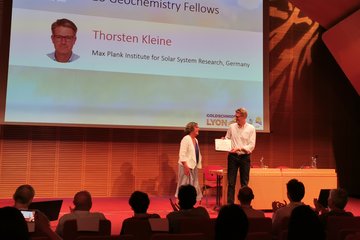Alle Typen
1.
Zeitschriftenartikel
Properties of the gas escaping from a non-isothermal porous dust surface layer of a comet. Monthly Notices of the Royal Astronomical Society 527, S. 12268 - 12283 (2024)
2.
Zeitschriftenartikel
Transmission probability of gas molecules through porous layers at Knudsen diffusion. Journal of Engineering Mathematics 144, S. 2 (2023)
3.
Zeitschriftenartikel
Cometary surface dust layers built out of millimetre-scale aggregates: dependence of modelled cometary gas production on the layer transport properties. Monthly Notices of the Royal Astronomical Society 522, S. 4781 - 4800 (2023)
4.
Zeitschriftenartikel
Sensitivity of modelled cometary gas production on the properties of the surface layer of the nucleus. Monthly Notices of the Royal Astronomical Society 519, S. 59 - 73 (2023)
5.
Zeitschriftenartikel
The effect of hierarchical structure of the surface dust layer on the modelling of comet gas production. Monthly Notices of the Royal Astronomical Society 510 (4), S. 5520 - 5534 (2022)
6.
Zeitschriftenartikel
Transport Characteristics of the Near-Surface Layer of the Nucleus of Comet 67P/Churyumov–Gerasimenko. Solar System Research 55, S. 106 - 123 (2021)
7.
Zeitschriftenartikel
The effect of varying porosity and inhomogeneities of the surface dust layer on the modelling of comet gas production. Monthly Notices of the Royal Astronomical Society 501 (2), S. 2635 - 2646 (2021)
8.
Zeitschriftenartikel
Pinnacles on the surface of the comet 67P/Churyumov–Gerasimenko: regional distribution and morphology. Monthly Notices of the Royal Astronomical Society 491 (2), S. 2664 - 2673 (2020)
9.
Zeitschriftenartikel
Cometary Comae-Surface Links: The Physics of Gas and Dust from the Surface to a Spacecraft. Space Science Reviews 216 (8), 130 (2020)
10.
Zeitschriftenartikel
Near-perihelion activity of comet 67P/Churyumov–Gerasimenko. A first attempt of non-static analysis. Monthly Notices of the Royal Astronomical Society 494 (3), S. 3310 - 3316 (2020)
11.
Zeitschriftenartikel
The phenomenon of shape evolution from solar-driven outgassing for analogues of small Kuiper belt objects. Monthly Notices of the Royal Astronomical Society 492 (4), S. 5152 - 5166 (2020)
12.
Zeitschriftenartikel
The Thermal, Mechanical, Structural, and Dielectric Properties of Cometary Nuclei After Rosetta. Space Science Reviews 215, 29 (2019)
13.
Zeitschriftenartikel
Correction to: The Thermal, Mechanical, Structural, and Dielectric Properties of Cometary Nuclei After Rosetta. Space Science Reviews 215 (5), 41 (2019)
14.
Zeitschriftenartikel
Lineaments on the Surface of the Consolidated Material of the Comet 67P/Churyumov−Gerasimenko Nucleus. Solar System Research 52 (6), S. 505 - 517 (2018)
15.
Zeitschriftenartikel
Dynamics of Dust Particles of Different Structure: Application to the Modeling of Dust Motion in the Vicinity of the Nucleus of Comet 67P/Churyumov–Gerasimenko. Solar System Research 52 (3), S. 266 - 281 (2018)
16.
Zeitschriftenartikel
Dynamical properties and acceleration of hierarchical dust in the vicinity of comet 67P/Churyumov–Gerasimenko. Monthly Notices of the Royal Astronomical Society 477 (4), S. 4896 - 4907 (2018)
17.
Zeitschriftenartikel
Pinnacles on the 67P cornet nucleus: Evidence for large scale erosion and hierarchical agglomeration of the nucleus. Planetary and Space Science 140, S. 80 - 85 (2017)
18.
Zeitschriftenartikel
Pinnacles on the 67P comet nucleus: Evidence for large scale erosion and hierarchical agglomeration of the nucleus. Planetary and Space Science 140, S. 80 - 85 (2017)
19.
Zeitschriftenartikel
Geologic analysis of the Rosetta NavCam, Osiris and ROLIS images of the comet 67P/Churyumov-Gerasimenko nucleus. Planetary and Space Science 137, S. 1 - 19 (2017)
20.
Zeitschriftenartikel
Cliffs versus plains: Can ROSINA/COPS and OSIRIS data of comet 67P/Churyumov-Gerasimenko in autumn 2014 constrain inhomogeneous outgassing? Astronomy and Astrophysics 605, A112 (2017)











